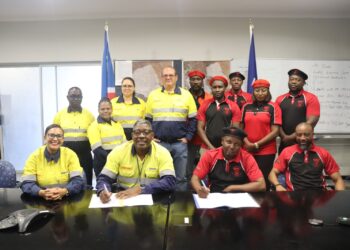
Green Hydrogen Commissioner James Mnyupe says key equipment to operationalise some of Namibia’s green hydrogen projects is now being delivered.
Giving an update, Mnyupe said Cleanergy Solutions Namibia has started receiving key components of its electrolyses for the country’s maiden hydrogen service station adding “we hope to cold commission the plant by Q1-2025â€.
The company, which was awarded a grant to set up a hydrogen pilot plant and refuelling station at Walvis Bay, is a joint venture between the Ohlthaver & List (O&L) Group and its international Belgium-based partner, CMB.TECH.
He said the Daures Green Hydrogen Village is set to receive an electrolyser and associated equipment in batches between mid-August and early September 2024, “The shipment is coming in batches and is in excess of 60 tonnes in weight,†Mnyupe said.
He said, following the delivery, the team will embark on the installation, integration, and commissioning of the equipment to ensure the facility operates at peak efficiency.
“The system will produce approximately 18 tonnes of green hydrogen and 100 tonnes of green ammonia,†he said.
The projects are being funded by the German Federal Ministry of Education and Research, through the Namibian Government, supported by the Southern African Science Centre for Climate Change and Adaptive Land Management.
Mnyupe also said HyIron, another key green hydrogen project, is working on delivering the first direct reduced iron of its kind in the world. Their innovative kiln is expected to arrive in Namibia by early September.
“The proprietary kiln that is to be used to make this new product is expected to arrive in Namibia in early September and HyIron aims to produce the first batch of local iron ore by the end of November,†he said.
The plant, which is being built near Arandis, will use renewable energy to produce iron based on HyIron technology, without any carbon emissions.
The plant is expected to start production in late 2024 and will initially produce 15,000 tonnes of Direct Reduced Iron per year, with zero carbon emissions released during the production process.
Renewable energy will replace fossil fuels in the conventional production process, powered by a solar and wind energy plant.
In the initial phase, a 20MW solar photovoltaic installation will provide carbon-free electricity to the Plant and as production scales up, an additional 18MW of wind energy and 140MW of solar energy will be integrated.
Additionally, the Green Hydrogen Programme is collaborating with the Maersk-McKinneyMoller Centre for Zero Carbon Shipping to develop a report detailing Green Maritime Corridors from Namibia.
This report, Mnyupe explained, is expected to be published at COP29, and will showcase Namibia’s potential as a global green hub, linking its green products and services to the international market.
“We will hold a workshop with local stakeholders on the margins of the Global African Hydrogen Summit in Windhoek one early September to showcase work done to date and invite further feedback on the exciting work that links Namibian green products and services to the world,†he said.
Mnyupe highlighted that the Green Hydrogen Programme is actively engaging with stakeholders, including the United Nations Country Representation and the Namibian Chamber of Environment, to ensure transparency and collaboration in the rapidly evolving sector.
Namibia aims to create 26,000 jobs in the green industrial sector by 2030.-miningandenergy.com.na











